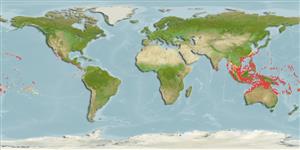Common names from other countries
>
Acanthuriformes (Surgeonfishes) >
Acanthuridae (Surgeonfishes, tangs, unicornfishes) > Acanthurinae
Etymology: Acanthurus: Greek, akantha = thorn + Greek, oura = tail (Ref. 45335).
More on author: Linnaeus.
Environment: milieu / climate zone / depth range / distribution range
экология
морской ассоциированный с рифами; пределы глубины 0 - 67 m (Ref. 1602), usually 2 - 67 m (Ref. 27115). Tropical; 21°C - 29°C (Ref. 27115); 30°N - 24°S
Eastern Indian Ocean: known only from Cocos-Keeling Islands and Christmas Island. Pacific Ocean: Ryukyu Islands and Great Barrier Reef to the Hawaiian Islands and French Polynesia (excluding Rapa). This species has crossed the Eastern Pacific Barrier to the Revillagigedo Islands, Cocos Island, Galapagos Islands, and the coast of Mexico.
Size / Вес / Возраст
Maturity: Lm ? range ? - ? cm
Max length : 36.0 cm FL самец/пол неопределен; (Ref. 125599); наибольший вес (опубликованные данные): 620.00 g (Ref. 125599); наибольший возраст (опубликованны данные): 34 годы (Ref. 52229)
колючие лучи спинного плавника (общее число) : 9; членистые (мягкие) лучи спинного плавника (общее число) : 28 - 31; колючие лучи анального плавника: 3; членистые (мягкие) лучи анального плавника: 26 - 28. A horizontally elongate white blotch directly below eye. No orange band in outer part of dorsal fin. Caudal peduncle black except for yellow edge of socket and sheath of peduncular spine. Base of pectoral fin black (ref 9808).Gill rakers on anterior row:17-19, on posterior row:18-20.
Adults inhabit hard substrate areas of clear lagoon and seaward reefs from the lower surge zone to at least 67 m and feeds on filamentous algae. Solitary or in groups (Ref. 90102). Monogamous (Ref. 52884, 48637). Benthopelagic (Ref. 58302). Small juveniles shy among large corals (Ref. 48637). Territorial species. Common throughout Micronesia and hybridizes with the rare A. achilles. Size of metamorphosis from the postlarva stage to juvenile is 5.5 to 6 cm (Ref. 9267). Minimum depth reported taken from Ref. 128797.
Life cycle and mating behavior
Maturities | размножение | Spawnings | Egg(s) | Fecundities | личинки
Monogamous mating is observed as both facultative and social (Ref. 52884).
Myers, R.F., 1991. Micronesian reef fishes. Second Ed. Coral Graphics, Barrigada, Guam. 298 p. (Ref. 1602)
Статус Красного Списка МСОП (Ref. 130435)
CITES (Ref. 128078)
Not Evaluated
Угроза для людей
Harmless
Использование человеком
рыболовство: рыболовство как средство для существования; аквариум: коммерческий
дополнительная информация
инструменты
Специальные отчеты
Скачать в формате XML
ресурсы в Интернет
Estimates based on models
Preferred temperature (Ref.
115969): 24.5 - 28.8, mean 27.4 (based on 650 cells).
Phylogenetic diversity index (Ref.
82804): PD
50 = 0.5000 [Uniqueness, from 0.5 = low to 2.0 = high].
Bayesian length-weight: a=0.02630 (0.01489 - 0.04645), b=2.93 (2.78 - 3.08), in cm Total Length, based on LWR estimates for this species & Genus-body shape (Ref.
93245).
Trophic level (Ref.
69278): 2.0 ±0.00 se; based on food items.
устойчивость к внешним воздействиям (Ref.
120179): средний (среднего размера), минимальное время удвоения популяции 1.4-4.4 года (K=0.28; growth and reproduction as expected for Medium; tmax=34 observed only in deep water (RF)).
Fishing Vulnerability (Ref.
59153): Low to moderate vulnerability (30 of 100).
